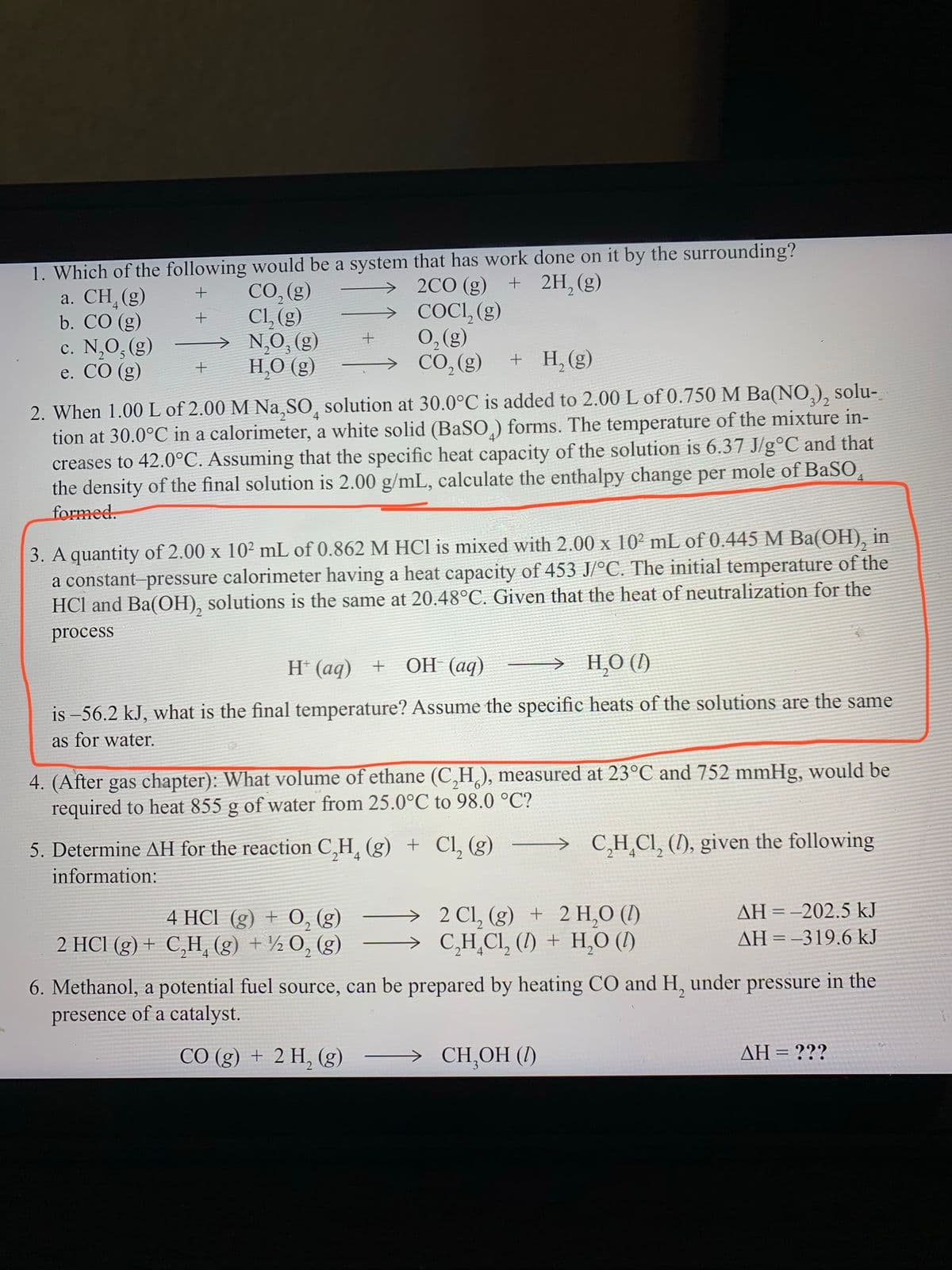3. A quantity of 2.00 x 10² mL of 0.862 M HCl is mixed with 2.00 x 10² mL of 0.445 M Ba(OH), in a constant-pressure calorimeter having a heat capacity of 453 J/°C. The initial temperature of the HCl and Ba(OH), solutions is the same at 20.48°C. Given that the heat of neutralization for the process H* (aq) + OH (aq) > H,O () is -56.2 kJ, what is the final temperature? Assume the specific heats of the solutions are the same as for water. 4. (After gas chapter): What volume of ethane (C,H), measured at 23°C and 752 mmHg, would be required to heat 855 g of water from 25.0°C to 98.0 °C?
3. A quantity of 2.00 x 10² mL of 0.862 M HCl is mixed with 2.00 x 10² mL of 0.445 M Ba(OH), in a constant-pressure calorimeter having a heat capacity of 453 J/°C. The initial temperature of the HCl and Ba(OH), solutions is the same at 20.48°C. Given that the heat of neutralization for the process H* (aq) + OH (aq) > H,O () is -56.2 kJ, what is the final temperature? Assume the specific heats of the solutions are the same as for water. 4. (After gas chapter): What volume of ethane (C,H), measured at 23°C and 752 mmHg, would be required to heat 855 g of water from 25.0°C to 98.0 °C?
Chemistry: The Molecular Science
5th Edition
ISBN:9781285199047
Author:John W. Moore, Conrad L. Stanitski
Publisher:John W. Moore, Conrad L. Stanitski
Chapter4: Energy And Chemical Reactions
Section: Chapter Questions
Problem 65QRT
Related questions
Question
Question #3. Thank you! The book states the answer should be 25.03 Celsius. I just don't know how to get that answer.

Transcribed Image Text:1. Which of the following would be a system that has work done on it by the surrounding?
a. CH, (g)
b. CO (g)
c. N,O, (g)
e. СО (g)
+ 2H, (g)
CO, (g)
CI, (g)
> N,0, (g)
H,O (g)
2CO (g)
COCI, (g)
0,(g)
CO, (g)
+ H, (g)
2. When 1.00 L of 2.00 M Na,SO, solution at 30.0°C is added to 2.00 L of 0.750 M Ba(NO,), solu-
tion at 30.0°C in a calorimeter, a white solid (BASO,) forms. The temperature of the mixture in-
creases to 42.0°C. Assuming that the specific heat capacity of the solution is 6.37 J/g°C and that
the density of the final solution is 2.00 g/mL, calculate the enthalpy change per mole of BaSO,
formed.
3. A quantity of 2.00 x 10² mL of 0.862 M HCl is mixed with 2.00 x 10² mL of 0.445 M Ba(OH), in
a constant-pressure calorimeter having a heat capacity of 453 J/°C. The initial temperature of the
HCl and Ba(OH), solutions is the same at 20.48°C. Given that the heat of neutralization for the
process
H* (aq) + OH (aq)
> H,O (1)
is –56.2 kJ, what is the final temperature? Assume the specific heats of the solutions are the same
as for water.
4. (After gas chapter): What volume of ethane (C,H), measured at 23°C and 752 mmHg, would be
required to heat 855 g of water from 25.0°C to 98.0 °C?
5. Determine AH for the reaction C,H, (g) + Cl, (g)
>
C,H_Cl, (I), given the following
4
information:
2 Cl, (g) + 2 H,O (1)
C,H̟CI, (1) + H,O (1)
AH =-202.5 kJ
4 HCl (g) + O, (g)
2 HCI (g) + C,H, (g) + ½ O, (g)
AH =-319.6 kJ
4
6. Methanol, a potential fuel source, can be prepared by heating CO and H, under pressure in the
presence of a catalyst.
CO (g) + 2 H, (g)
CH,OH (1)
AH = ???
Expert Solution
This question has been solved!
Explore an expertly crafted, step-by-step solution for a thorough understanding of key concepts.
This is a popular solution!
Trending now
This is a popular solution!
Step by step
Solved in 2 steps with 3 images

Knowledge Booster
Learn more about
Need a deep-dive on the concept behind this application? Look no further. Learn more about this topic, chemistry and related others by exploring similar questions and additional content below.Recommended textbooks for you

Chemistry: The Molecular Science
Chemistry
ISBN:
9781285199047
Author:
John W. Moore, Conrad L. Stanitski
Publisher:
Cengage Learning

Principles of Modern Chemistry
Chemistry
ISBN:
9781305079113
Author:
David W. Oxtoby, H. Pat Gillis, Laurie J. Butler
Publisher:
Cengage Learning

General Chemistry - Standalone book (MindTap Cour…
Chemistry
ISBN:
9781305580343
Author:
Steven D. Gammon, Ebbing, Darrell Ebbing, Steven D., Darrell; Gammon, Darrell Ebbing; Steven D. Gammon, Darrell D.; Gammon, Ebbing; Steven D. Gammon; Darrell
Publisher:
Cengage Learning

Chemistry: The Molecular Science
Chemistry
ISBN:
9781285199047
Author:
John W. Moore, Conrad L. Stanitski
Publisher:
Cengage Learning

Principles of Modern Chemistry
Chemistry
ISBN:
9781305079113
Author:
David W. Oxtoby, H. Pat Gillis, Laurie J. Butler
Publisher:
Cengage Learning

General Chemistry - Standalone book (MindTap Cour…
Chemistry
ISBN:
9781305580343
Author:
Steven D. Gammon, Ebbing, Darrell Ebbing, Steven D., Darrell; Gammon, Darrell Ebbing; Steven D. Gammon, Darrell D.; Gammon, Ebbing; Steven D. Gammon; Darrell
Publisher:
Cengage Learning

Physical Chemistry
Chemistry
ISBN:
9781133958437
Author:
Ball, David W. (david Warren), BAER, Tomas
Publisher:
Wadsworth Cengage Learning,

Chemistry: Principles and Practice
Chemistry
ISBN:
9780534420123
Author:
Daniel L. Reger, Scott R. Goode, David W. Ball, Edward Mercer
Publisher:
Cengage Learning

Chemistry
Chemistry
ISBN:
9781305957404
Author:
Steven S. Zumdahl, Susan A. Zumdahl, Donald J. DeCoste
Publisher:
Cengage Learning